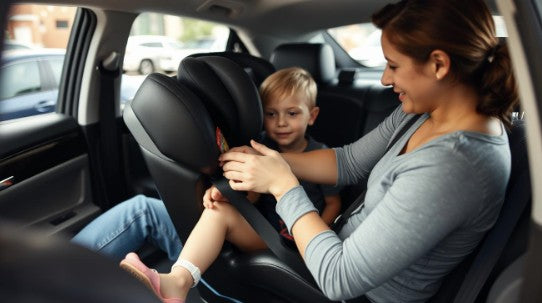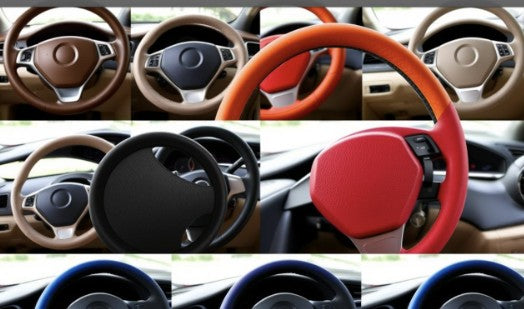Traveling with children brings unique challenges, especially when it comes to car safety in unfamiliar vehicles. Whether you're hailing a taxi in a new city or picking up a rental car at your vacation destination, ensuring your child's safety requires planning and knowledge. Many parents wonder if they should rent car seats, bring their own, or if taxis are exempt from car seat requirements.
This comprehensive guide will walk you through everything you need to know about using car seats safely in rental cars and taxis. We'll cover choosing travel-friendly options, proper installation techniques, and essential safety checks to give you peace of mind during your journey.
Choosing the Right Car Seat for Travel
When traveling with children, selecting the appropriate car seat can make the difference between a stressful journey and a smooth one. The right travel car seat balances safety, portability, and ease of installation.
Portable vs. Standard Car Seats
Standard car seats provide excellent protection but can be bulky and heavy to transport. Travel-specific car seats are designed to be lightweight and compact without compromising safety. Consider these key differences:
Travel Car Seats: Advantages
- Lightweight (typically 8-12 pounds)
- Compact design for easier transport
- Often FAA-approved for airplane use
- Simplified installation features
- More convenient for taxi use
Standard Car Seats: Limitations
- Heavier (15-25+ pounds)
- Bulky to carry through airports
- Risk of damage when checked
- More challenging to install quickly (taxi situations)
- Takes up more space in small rental cars
Recommended Travel-Friendly Car Seats
Based on weight, ease of installation, and compatibility with various vehicles, these car seats are particularly well-suited for travel scenarios:
For Infants (0-12 months)
Chicco KeyFit 35 - Lightweight infant seat that can be installed securely without the base using the European belt path. Perfect for quick taxi rides and rental cars.
For Toddlers (1-4 years)
Cosco Scenera NEXT - Weighing under 8 pounds, this convertible seat is budget-friendly and can be installed rear or forward-facing. Ideal for traveling with toddlers.
For Older Children (4+ years)
Wayb Pico - Forward-facing travel seat that folds compactly for easy transport. FAA-approved for airplane use and quick to install in taxis and rental cars.
Important: Never rent car seats from rental car companies. Research shows these seats often have unknown histories, may be expired, damaged, or improperly cleaned. The minimal convenience isn't worth the safety risk to your child.
Car Seat Installation Checklist for Rental Cars and Taxis
Proper installation is crucial for car seat effectiveness. Follow these step-by-step guidelines based on your child's age and seat type:
Rear-Facing Seat Installation
- Choose the safest position - Center of back seat when possible, or behind passenger seat if center installation isn't secure
- Check for LATCH anchors - Many rental cars have them, but they may be hidden in seat creases
- If LATCH is available, connect lower anchors until they click
- If no LATCH, prepare to use seat belt installation
- Thread the seat belt through the correct belt path
- For infant seats without base: Use European belt path when available (routes shoulder belt around back of seat)
- For convertible seats: Follow the clearly marked rear-facing belt path
- Remove all slack - Press down firmly on the seat while tightening the belt
- Check recline angle - Use built-in indicators to ensure proper recline (especially important for infants)
Forward-Facing Seat Installation
- Position the seat - Center or outboard position in back seat only
- Locate tether anchor - Critical for forward-facing safety; found on seat back, floor, or ceiling in rental cars
- If no tether anchor available in taxis, consider using a rear-facing seat if child still fits
- Connect LATCH or thread seat belt through forward-facing belt path
- Tighten installation - Use your body weight to compress seat while removing slack
- Attach and tighten tether strap - This reduces forward head movement in crashes by up to 8 inches
Booster Seat Setup
- Position booster on vehicle seat - Ensure it sits flat and stable
- Seat child with back against booster back (for high-back boosters)
- Route seat belt correctly
- Lap portion low across hips/upper thighs (not stomach)
- Shoulder portion across center of shoulder (not neck or arm)
- Check belt fit - Belt should be snug and properly positioned
Taxi-Specific Tip: For quick taxi rides, have your installation strategy ready before hailing the cab. Practice makes perfect - try a few "dry runs" at home to become efficient at installing your seat quickly.
Securing Your Child Correctly
Even with perfect installation, your child's safety depends on proper harnessing. Here's how to ensure your child is secured correctly in any vehicle:
Harness Tightness Test
The harness should be snug enough that you cannot pinch excess webbing at the shoulder. Think of it as "snug as a good handshake" - secure but not uncomfortable. This prevents dangerous movement during sudden stops or crashes.
Chest Clip Positioning
The chest clip should always be positioned at armpit level. Too low and it doesn't do its job of keeping the harness straps properly positioned; too high and it can cause injury to the neck area in a crash.
Winter Coat Safety
Bulky winter coats create a dangerous space between your child and the harness straps. In a crash, this extra space allows for excessive movement that can lead to injury. Instead:
- Remove bulky coats before securing child in the seat
- Place coat on backwards over the secured harness for warmth
- Use thin fleece jackets that don't interfere with harness tightness
- Bring a blanket to place over the secured harness
Warning: Never use aftermarket products like strap covers, head positioners, or seat protectors unless they come with your car seat or are explicitly approved by the manufacturer. These can interfere with the seat's tested safety performance.
Post-Installation Safety Checks
After installing your car seat in a rental car or taxi, perform these critical safety checks before starting your journey:
- The "Inch Test" - Grasp the car seat at the belt path and try to move it side-to-side and front-to-back. It should not move more than 1 inch in any direction.
- Recline Angle Check - Confirm the seat is at the correct angle for your child's age using the built-in indicators.
- Harness Strap Height - Verify straps are at or below shoulders for rear-facing, at or above shoulders for forward-facing.
- Tether Inspection - For forward-facing seats, confirm the tether is connected and tight.
- Seat Belt Locking - Ensure the vehicle seat belt is in locked mode (pull all the way out and let it retract to lock).
- Secure Objects - Check that all loose items in the vehicle are secured to prevent them becoming projectiles in a crash.
"The best car seat is the one that fits your child correctly, fits your vehicle correctly, and that you will use correctly every time." - National Highway Traffic Safety Administration
Pro Tips for Traveling with Car Seats
Make your journey smoother with these expert tips for managing car seats during travel:
Tip #1: Pool Noodle Trick
Pack a 6-inch section of pool noodle to help achieve the correct recline angle for rear-facing seats in rental cars with sloped seats. Place it under the front edge of the car seat base.
Tip #2: Seat Belt Locking Clip
Bring a metal locking clip for vehicles without self-locking seat belts (common in some international destinations). This ensures a tight installation in any vehicle.
Tip #3: Gate-Check Protection
If you must gate-check your car seat, use a padded travel bag and clearly label it "FRAGILE - CHILD SAFETY DEVICE." Better yet, take it on the plane if FAA-approved.
Tip #4: Installation Video
Before traveling, save an offline installation video specific to your car seat model on your phone. This provides a quick reference if you encounter difficulties.
Tip #5: Seat Protector Alternative
Instead of bulky seat protectors that can interfere with installation, bring a thin receiving blanket to protect rental car upholstery from snack crumbs and spills.
Tip #6: Practice Run
Before your trip, practice installing your car seat using just the seat belt in different positions. This builds confidence for quick taxi installations.
Frequently Asked Questions
Do taxis and rideshare services provide car seats?
Some do, but availability is limited and quality varies greatly. In New York City, some taxis offer car seats, while Uber offers "Uber Car Seat" in select cities for an additional fee. However, these seats may not be properly maintained or suitable for your child's size. For safety and peace of mind, bringing your own travel car seat is strongly recommended.
What if my rental car lacks LATCH anchors or tether points?
All vehicles manufactured after September 2002 should have LATCH anchors, but they might be difficult to locate. If truly unavailable, use the seat belt installation method following your car seat manual. For forward-facing seats without a tether anchor, consider requesting a different vehicle if possible, as the tether significantly reduces head movement in crashes. If no alternative is available, a seat belt installation without the tether is still safer than no car seat.
Are car seats legally required in taxis and rental cars?
Laws vary by location. In most U.S. states, children must be in appropriate car seats in rental cars, just like in private vehicles. For taxis, many states have exemptions, but these are safety exemptions, not safety recommendations. Even where not legally required, using a car seat in taxis is essential for your child's safety. Always check local laws at your destination before traveling.
Ensuring Your Child's Safety on the Go
Traveling with children requires extra planning, but their safety is worth every effort. By choosing the right travel car seat, mastering proper installation techniques, and performing thorough safety checks, you can protect your child in any vehicle, anywhere in the world.
Remember that even in locations where car seats might not be legally required in taxis, physics doesn't change - children need the same protection in all moving vehicles. Your vigilance as a parent makes all the difference in keeping your little ones safe during travel adventures.
Car Seat Travel Checklist
Get our printable checklist to ensure you never miss a critical step when installing your child's car seat in unfamiliar vehicles.
Before your trip, be sure to research the specific car seat laws at your destination, as requirements vary by country and even between states. Safe travels!




Leave a comment
This site is protected by hCaptcha and the hCaptcha Privacy Policy and Terms of Service apply.